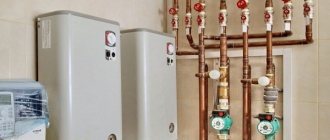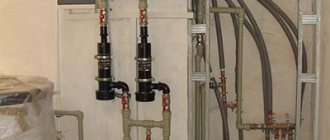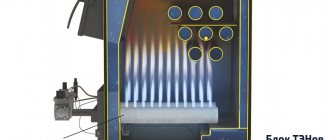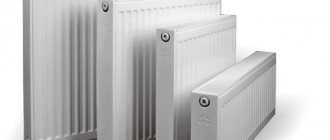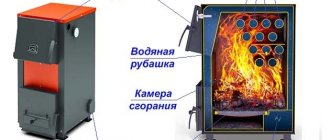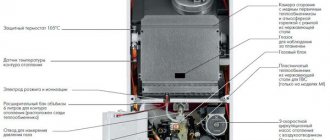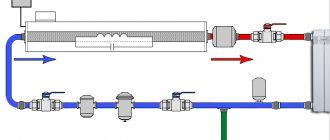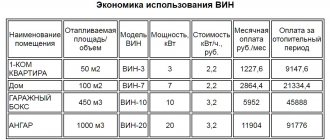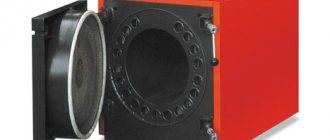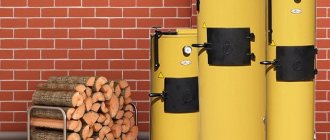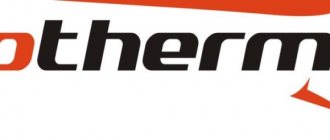Advantages and disadvantages
Is it convenient to use this type of boiler for heating? I guess, yes. It is especially good in places where the network voltage is unstable: even when the voltage drops to 180 V, the electrode boiler continues to operate. Its power drops, but it continues to work. What else is such a system convenient for: if you have competent automation and the correct connection of the boiler, the system is autonomous and can maintain the set temperature independently. Another positive point: if for some reason water disappears from the system, the equipment will simply stop working. It won’t burn, won’t deteriorate, but simply won’t work, since water, in this case, is the working medium. Without it, there is no current.
One example of installing an electrode boiler
Now about the disadvantages. From the principle of operation of the electrode boiler, their main drawback emerges: they are demanding on the composition of the water. Not just any water is suitable, but with certain characteristics. When starting the system, it is necessary to prepare the coolant according to the recommendations of the boiler manufacturer. Usually this is a few teaspoons of salt or soda per liter of water in the system. That's all. You can also use special liquids that are produced by the same manufacturers. But this is for those who don’t want to bother at all.
On the other hand, by changing the composition of the water, you can “adjust” the power of the boiler to your needs: in principle, you can make it work with both more and less power relative to what is stated in the passport. All you need to do is change the chemical composition of the coolant-electrolyte
Here it is important not to overdo it, otherwise you can “modify” the composition until the boiler completely and instantly fails. Therefore, stay within the limits specified by the manufacturer (as usual, “from” and “to” are indicated)
Another unpleasant moment. Even more. The current spreads in the water, and the water circulates in the system. And, in principle, it is possible that if you touch the radiator you will receive a considerable electric shock. This leads to another indispensable condition for safe operation when using electrode boilers for water heating: high-quality and reliable separate grounding is required. It will just help avoid such a situation.
Not the most pleasant moment is the need to periodically clean the system and replace the electrodes - they gradually become thinner and the heating efficiency decreases. In this regard, electrode boilers do not have any advantages over traditional electric boilers with heating elements.
How to choose the right electric boiler
To choose an electric boiler, first of all you need to determine the power of the heating device for your home - at the rate of 1 kW per 10 sq. m. of insulated room with ceilings up to 3 meters.
adjust power to reduce your costs.
When choosing a boiler, you need to pay attention to the equipment. Almost all boiler models are equipped with a circulation pump and an expansion tank, allowing the boiler to be used for heating a room and preparing hot water at the same time
The latest models have different levels of protection against negative influences - a filter for cleaning the coolant, operation in summer and winter modes, anti-freeze protection devices, etc.
Choosing a thermostat
In order to achieve economical energy consumption, it is necessary to choose the right thermostat for the electric boiler. Using a thermostat, you can maintain different temperatures in individual rooms. To do this, you need to set the required value, and the system will track it automatically.
Types of automation
Mechanical automation includes primitive control devices - thermal relays, bimetallic thermostats, contactors of the 2nd, 4th, 6th magnitude, etc.
- the advantages of mechanical automation are low price;
- Cons: inaccurate heating control and strong popping noises during operation.
This type is usually used in non-residential, warehouse and industrial premises.
Electronic automation is much more economical than mechanical (precise heating control) by about 20% and has a lower noise level. Electronic thermostats maintain the specified temperature automatically, taking into account additional heat sources. Most often, automatic thermostats are installed at the heating devices of tall buildings on the upper floors, since the air on the lower floors is always colder and therefore the heated air rises from bottom to top. It is practical to install thermostats in rooms where there are additional heat sources, for example, in the kitchen.
amount of heat, save up to 20%
The most common are liquid thermostats. They are more expensive, but their service life is much longer - 20 years and they are more accurate in operation. When choosing a gas-filled thermostat, choose the option with a remote sensor, because the built-in sensor will require a more rigid installation.
Digitally controlled thermostats control the operation of heating systems, heating devices, ventilation and hot water supply systems. They are used for a comprehensive solution - control of systems that involve many parameters - humidity, time, temperature.
Design and principle of operation of an electrode boiler
Since the operating principle of the installation is not particularly complicated, the design of the units is extremely simple.
Electrode boiler includes:
- Frame;
- Terminal for connecting the neutral wire;
- Base;
- Electrode;
- Terminal for connecting the phase wire;
- Inlet pipe;
- Outlet pipe;
- casing;
- Terminal for connecting grounding or grounding.
In most designs, the role of the second electrode is played by the body of the device1
, connected to the neutral wire through the terminal
2
.
The container is hermetically sealed on one side with a base 3
, in which the central electrode
4
.
Voltage is supplied to the rod by a phase wire through terminal 5
.
The coolant is supplied through the inlet pipe 6
located at the bottom of the unit.
The heated coolant enters the heating line through the outlet pipe 7
, usually located in the top cover of the product. For installation of fittings, both pipes have threaded ends.
External casing 8
, has a special terminal
9
for connecting the ground wire and serves as additional protection against electric shock. In addition, the shape and polyamide coating of the casing can provide an attractive appearance to the entire installation.
To increase the efficiency of the heating system, a circulation pump is installed in front of the inlet pipe, ensuring intensive passage of liquid through the working cavity of the device.
If a power of more than 10 kW is required to achieve the required result, it is advisable to use an electrode boiler connected to a three-phase power supply.
The operating principle of a three-electrode unit does not differ from the operating principle of a conventional boiler; the difference lies in the number of rods and their placement. Each electrode is connected to a separate phase through special terminals at the bottom of the installation. The rods are located at the vertices of a regular equilateral triangle inscribed in the circumference of the working cylinder. A terminal on the housing is used to ground the device.
Since the electrodes can be destroyed during operation, the design of the installation provides for their prompt replacement. To do this you need:
- Drain the coolant from the heating system;
- Detach the bottom cover;
- Replace damaged electrodes;
- Place the bottom cover in place and check the tightness of the fastening;
- Fill the line with liquid electrolyte;
- Restore power supply.
The advantage of electrode installations is that in the absence of coolant in the system, there is no destruction of boiler parts.
Control systems
Since the design of the boiler itself does not provide for any control elements, adjustment is carried out using external control systems.
The simplest unit consists of one temperature sensor installed in front of the inlet pipe and turning off the power supply when the set temperature is reached. More precise adjustment is carried out using two temperature sensors located at the input and output.
The cost of an automatic control system is the most significant component of the price of an electrode boiler, which can vary over a fairly wide range.
The main advantages and disadvantages of heating with electricity
Electricity also cannot be called cheap, however, electric boilers have a number of significant advantages over other types of heating equipment:
- installation of an electric boiler is not too expensive and does not require a specially designated room equipped with supply ventilation and a chimney;
- heat generators, the operation of which is based on the conversion of electricity into heat, do not emit substances into the surrounding space that can harm human health;
- there is no need to stock up on any type of fuel for the heating period, allocating the necessary space for it, as, for example, when using wood-burning boilers;
- electric boilers produce heat almost silently, which distinguishes them favorably from thermal units operating on various fuels, for example, particularly noisy diesel boilers;
- a high degree of operating autonomy does not require constant human intervention.
The main disadvantages of electric boilers include:
- relatively high heating costs;
- significant heat loss in the coolant;
- dependence on the electrical network.
Currently, the cost of electricity is constantly rising, which leads to increased heating costs. A priority way to increase the efficiency of heating systems these days is to install automation (thermal heads, programmers, etc.), which turn the electric boiler on and off at the right time, maintaining the temperature at a given level. To protect parts of the device from network surges, install either a general (for the whole house) or a local voltage stabilizer. Installing a general stabilizer will also be useful for all other household electrical appliances in the house.
Will an electric boiler really be useful?
In modern conditions, gas is not accessible to everyone. Some settlements are located far from the main highway. And at times, purchasing and installing a gas boiler makes no sense at all.
For example, for a country house, which is not used very often, it is not advisable to use expensive gas equipment. And boilers that use solid fuel have many disadvantages. For example:
- Most of these units cannot operate on one load for more than five hours;
- There is no way to control the heating temperature;
- Fuel must be prepared ahead of time and in large quantities.
If you take all this into account, then an electric boiler for a private home will indeed become a good and more reliable option.
The main advantages of an electric boiler:
Electric boilers take up less space. Electric boilers can be installed anywhere you like because they don't have a chimney that needs to be routed through your home. There is no mandatory condition to install an electric boiler for heating a private house near an external wall.
An electric boiler for heating a private house can be located in the center of the cottage or in any other place that you really like. An electric boiler does not require a fuel tank, like oil or propane units. This means you save space that would normally be devoted to fuel.
Advantages of an electric boiler:
- High degree of automation;
- It does not require a separate room;
- It is possible to control the heating temperature;
- Easy and fairly quick installation, simple connection and maintenance;
- Can be mounted even on the wall, without outside help;
- Doesn't make noise;
- There is no need to connect it to the chimney.
Electric boilers are safer than gas boilers. You won't have to worry about gas leaks in your home when you rely on an electric boiler. For this reason, these devices are completely safe and can be placed outside your home. They are not that difficult to install. You will feel safe as the heating system will provide the necessary amount of heat without causing any problems.
Cons of electric boilers
While electric boilers have quite a few advantages, there are some disadvantages to using these hydronic heating systems in your home. Electric boilers can potentially cost more than gas boilers. An electric boiler also limits the amount of hot water it can produce. And most importantly, electric boilers leave you at the mercy of the power companies in the event of a power failure.
- If the boiler power is over nine kilowatts, keep in mind that they are produced only for a three-phase voltage of 380 watts;
- A separate cable is required to connect to the meter;
- You have to pay more than usual due to the high electricity tariffs.
Electricity is simply more expensive than gas in most regions of Russia. This means that by relying on electricity to heat your water and home, you'll end up spending more money. Even if your device consumes electricity more efficiently than a gas boiler. In most cases, the financial costs are higher to generate the same amount of heat.
Pros and cons of electrode boilers for heating
Despite conflicting reviews from owners, one cannot fail to note the obvious advantages of electrode installations:
- The design of the boiler ensures compactness and ease of connection.
- Small overall dimensions allow the units to be used as additional or backup heat generators, switched on independently of the main one as needed.
- No design or approval is required to install the boiler.
- If there is a coolant leak, the device will not fail and can continue to operate immediately after the problem is corrected.
- Electrode boilers are not susceptible to voltage surges in the electrical network.
- Lack of harmful emissions and powerful electromagnetic fields.
The list of advantages is indeed significant, but along with them, some objective disadvantages should be noted:
- The use of electrode devices is not advisable if the heating system contains radiators made of steel or cast iron. Effective operation can only be ensured by bimetallic batteries and high-quality aluminum radiators, which significantly increases the cost of the heating circuit.
- High requirements for the quality and chemical properties of the coolant. The liquid used must provide optimal conditions for electrolysis.
- Installation of an electrode boiler is only possible in a closed circuit, which entails additional costs for a sealed expansion tank, an emergency pressure relief valve and an air vent.
- The maximum heating temperature of the coolant should not exceed 85C.
Having carefully analyzed all the shortcomings of the unit, we can come to the conclusion that they are all related to the quality and chemical properties of the coolant.
Electrode boilers
Such electric boilers for heating a private home heat water or other liquid through electrolysis. Steel electrodes are located inside the device. After connecting the current, a potential with an alternating sign is formed and thus the movement of ions occurs.
The polarity changes along with the network frequency - approximately fifty times per second. This causes the liquid to heat up quickly. In order for the entire process to take place at the desired level of intensity, a very important nuance is to maintain the electrolyte density at a stable level. The liquid acts as this electrolyte.
But do not neglect the user instructions for the newly purchased boiler. Take, for example, the rather popular model of the Galant electrode type. The instructions indicate the requirements for the liquid, which must comply with GOST 2874-82. This means that drinking water for this boiler must be endowed with a resistivity of 1.3 thousand ohms per 1 cubic centimeter.
For liquids that will be heated in a boiler of this type, preliminary preparation is necessary, as well as vigilant density control. Otherwise, the power and efficiency of the device inevitably decreases, and it may become insufficient to warm the house.
The strengths of such boilers:
- medium sizes;
- low cost;
- complete safety. If a liquid leak starts, the electric boiler will turn off and not burn out, as can happen in the case of a heating element.
Weak spots:
- The importance of constantly monitoring the density of the liquid;
- Over time, the electrodes dissolve, so they must be replaced periodically.
Installation of an electric boiler for heating a private house
Installation of an electric boiler and heating in general is allowed in a private household without issuing special permits and documents (gas equipment is installed only with the permission of the relevant services). All operations, if you have basic technical skills, can be carried out on your own.
First of all, you need to choose a location for installation. The ideal option is a separate room with a connected power line, which is not accessible to children. Boilers equipped with heating elements (tubular heating elements) are quite often located in the kitchen
During installation, care should be taken to ensure that there is a distance between the elements of the electric boiler and the surface of the walls, ceiling and floor, allowing for maintenance and repair of the heat generator. When marking the fasteners, you must use a level and make sure that the boiler is installed strictly horizontally
When connecting heating pipes to the inlet and outlet pipes of an electric boiler, it is necessary to eliminate the load on the unit body. Pipes and elements placed on it (taps, circulation pump, etc.) must be securely attached to supporting structures or walls.
Features of using an electric boiler
The device, operating from a household network, heats rooms by converting current into thermal energy.
The equipment is used for heating and organizing autonomous hot water supply in the house. Electric boilers are equipped with additional functions that simplify the management of the system.
This type of device is environmentally friendly and safe. However, a stable power supply voltage is required.
Types of equipment
Manufacturers produce 3 types of such boilers: classic with heating elements, electrode and induction.
The first ones are equipped with a thermal heating element - a metal tube, which is filled with quartz sand. It contains a spiral made of tungsten or nichrome, its ends are brought out to connect wires that supply voltage.
The heating elements are located in the tank of the boiler unit. The power depends on the number of heaters. The device is equipped with a control unit whose sensors monitor temperature and pressure.
Electrode boilers are units coated with insulating material. They are more compact in size. One or more electrodes are placed inside the device, to which phase wires are connected.
Zero or grounding is fixed to the housing. The units have high efficiency and are characterized by rapid heating of the coolant. Heating with a heating element boiler is a less effective method, but such devices are the cheapest and easiest to maintain.
Devices operating by electromagnetic induction have a coil in their design. When current flows, the core heats up and the generated heat is transferred to the liquid circulating in the heating system.
The units are demanding on the purity of water: it must be distilled.
How boilers work
The operating principles of electrical equipment depend on the design of the devices.
The temperature of the liquid in the heating system is increased by:
- when heat is generated by current, if tubular heating elements are used;
- due to electromagnetic induction;
- by passing current through the liquid circulating in the device.
A pump installed in the main pipeline pumps heated water from the boiler through it to the heat exchangers, which are located in the room. The temperature of the liquid in the system is adjusted using an automation unit that ensures periodic switching on of the device.
The units are equipped with a set of sensors that monitor operating parameters and allow adjustments to be made to them. To facilitate setup and control, programmable room thermostats are connected to the devices.
Advantages and disadvantages
Advantages of electric boilers:
- there is no need to install a chimney or exhaust hood;
- no need to equip a separate room;
- environmental Safety;
- small dimensions.
Flaws:
- energy dependence;
- high cost of electricity;
- sensitivity to voltage changes;
- the need to install additional wiring.
For stable operation of the installation, stabilizers or uninterruptible power supplies are needed.
Equipment classification and operating principle
An electric boiler converts electrical energy into heat and, depending on the design features, can be:
- TENOV;
- electrode;
- induction.
Regardless of the type, modern models are equipped with a thermostat, with which you can adjust the power of the device and the degree of heating of the coolant.
Usually it is also possible to receive information from an external sensor to control the temperature of the air mass in a specific room.
Device with heating element
Inside the container intended for water, heating elements are installed - heating elements. They can be made in the form of tubes or plates. To regulate the degree of heating, the heaters are turned on one by one.
Water enters the tank, is heated, and then transferred to the circuit. As it cools or heats up, individual heating elements turn on or off. The movement of the coolant is controlled by a built-in circulation pump.
Depending on the size and type of heating elements, electric boilers are wall-mounted or floor-mounted. You need to choose a place to install the device so that it is convenient to service.
You can choose double-circuit models of such boilers; they heat water not only for heating, but also for plumbing. Heating element devices are popular due to their simple design and relatively low price. When used correctly, they rarely break down.
In addition to water, antifreeze or oil compositions of various concentrations are used as a coolant. But the sizes of such devices are usually quite large, which limits the possibilities when choosing a place to install them. Over time, plaque settles on the heating elements, and the heating elements need to be replaced periodically.
Electrode boiler for heating
For heating, the potential difference at two electrodes and the natural resistance of water, which arises due to the salts dissolved in it, are used here. These are compact devices that can quickly heat small volumes of water.
Electrode boilers are very compact and easy to install, but such devices only work with water that has a certain resistivity
A built-in circulation pump is not needed here. This is a simple device that almost never breaks. And if this happens, it is not difficult to repair it. The price for devices of this type can be called affordable.
But oil and antifreeze are not suitable for such a boiler; only water, not distilled water, is acceptable as a coolant. Over time, the electrodes wear out and dissolve in water. They need to be periodically replaced with new elements.
Induction heating device
In such boilers, the heating element is made of a dielectric housing with a coil and core wound on it. The current in the coil causes a potential difference in the core, which heats up quite quickly. Thermal energy is transferred to the coolant.
Boilers with the induction operating principle are resistant to wear, they have high efficiency and last an exceptionally long time. The design is so simple that it can be made from available materials
This is a boiler with high efficiency and a long service life. Industrial models are quite expensive, but if you wish, you can make a homemade induction analogue. Any coolant liquid is suitable, and breakdowns are extremely rare.
Tips for choosing an electric boiler
Practical and economical option
Basically, the reliability of an electric boiler is judged by its power. For good single-circuit heating equipment this figure is 1 kW per 10 m2. Double-circuit boilers must have an increased power value.
You can incur much lower costs from using an electric boiler if it is equipped with a safety system, expansion tank, circulation pump and programmer. Ionic electric boilers have all this. It will also be possible to reduce energy costs by purchasing an electric boiler with components that increase the equipment’s capabilities during the off-season.
Choosing the best boiler model
Most often, Protherm electric boilers are purchased in stores. Under this name, a huge range of devices are produced that have excellent quality at a relatively low cost.
It is customary to install boilers in private homes, hanging them on the wall or placing them on the floor. They operate reliably and feature an easy-to-understand control panel and user-friendly LCD display. A pump comes with the equipment set. Boiler models from this company are compact in size.
Heating devices are produced with a power from 6 to 28 kW. Most models are connected to a power supply with a voltage of 380 V. If necessary, automatic diagnostics of operation can be carried out on their control panel.
Wall-mounted compact model
Another winning option is the Russian-made Evan electric boiler. It operates silently and is considered reliable equipment for heating a private home. The heat exchanger of this device is designed so that there is no risk of leakage.
The Evan boiler is equipped with a circulation pump and an expansion tank. The use of this equipment is absolutely safe, since it contains a microprocessor unit. The heating temperature of the boiler can be changed, thereby reducing electricity costs.
Connecting the boiler to the heating system
The equipment is no less famous. Electric boilers made in Germany have a power value from 4 to 60 kW. This heating equipment includes a circulation pump. The boiler is equipped with a safety valve, filter and water pressure sensor.
Several boiler models have a built-in expansion tank. Heating devices with a power of no more than 12 kW are connected to a network with any voltage.
This boiler allows you to control the temperature
Features of choice
After deciding to purchase an electric boiler, you need to understand the types and technical parameters that distinguish different models.
Technical characteristics of electric heating boilers EVP Stanless
Types of boilers
Electric boilers are:
- Heating elements.
- Induction.
- Electrode.
Heating element boilers are the most common. They work the same way as a kettle. Heat is transferred into the room by driving water through pipes, heated by boiler heating elements. Different boiler models can have from 1 to 3 heating elements. The power indicated for an electric boiler is the total power of all its heating elements. The water in the pipes is driven by a circulation pump.
The models have been on the market for a long time - the work has been streamlined, the design has been thought out.
Heating element heating boiler - diagram
Induction boiler. It has a dielectric tube wrapped with wire, inside which there is a core closed to itself (made of any metal to which a magnet can stick). The current passing through the coil creates an electromagnetic field and causes the molecules in the core to move, heating it.
An induction boiler is a very reliable device. The only thing that can break in it is the electronic control unit. The price of induction boilers is higher than others. But the sellers’ assurances about innovative technologies and great efficiency are based on nothing and contradict the laws of physics. Induction principles were discovered by M. Faraday almost 2 centuries ago and have long been successfully used in industry.
Induction electric boiler
Electrode boilers heat by passing current through the water. The problem is that you can only use water that can be called “drinking” according to GOST.
The electrodes in such boilers dissolve over time and require replacement.
Heating element boilers should not be connected to a running water supply - scale forms on the heating elements, which is more difficult to deal with than in a kettle. Therefore, it is better to use the same coolant in the system. Also take a closer look at models that have filters.
Power
The power of the unit will depend on the dimensions of the room to be heated.
An important role will be played by the quality of insulation and thermal conductivity of the building materials used in the construction of the house.
Approximate calculation for a reliably insulated house with a ceiling height of about 3 meters:
For 10 m2 of area, 1 kW of electricity is required.
If the house is located in areas with harsh winters, you need to add 10% to the resulting power indicators.
Choose units in which the power can be adjusted taking into account the weather (the thermostat can be built-in or connected separately). Then the theoretical costs of electricity will actually be much lower.
Voltage and cable
It is allowed to connect electric boilers with a power of less than 12 kW to a single-phase 220 volt network.
Devices over 12 kW are connected only to a three-phase 380 volt network. In both cases, you need to connect through a separate machine on the meter, which will protect the network.
Before buying powerful boilers, evaluate the real capabilities of your electrical networks.
The cross-section of the cable should be larger, the higher the load on it and the more devices will operate simultaneously in the house.
For example, a 4mm2 copper wire at a voltage of 220 v can power an 8 kW boiler, and at a voltage of 380 v – a power of 19 kW. A copper wire with a cross section of 6 mm2 at a voltage of 220 v will pull 10 kW of power, and at a voltage of 380 v - 26 kW.
To save energy, it is very beneficial to accumulate heat and then use it. The heat accumulator for heating boilers is designed precisely for these purposes. Read about how to make a homemade battery.
The operating principle of automation for heating boilers is discussed here.
Did you know that a device such as a three-way heating valve can be very useful? Here https://microklimat.pro/sistemy-otopleniya/montazh-sistem-otopleniya/kran-trexxodovoj.html you will find out what the part is and what it is used for.
Manufacturer
The most affordable boilers, which have proven themselves to work well, are from domestic companies - RusNit, Nevsky, Evan.
German units (Bosch) will cost the most. They are crammed with automation and are famous for their reliability.
Wall-mounted heating boiler Evan
Other popular manufacturers:
- Eleko, Elbeva, Protherm (Slovakia) - adapted to the Russian climate;
- Dacon (Czech Republic) - about 30 boilers with a capacity from 4 to 60 kW;
- Kospel (Poland).
Boiler equipment
When purchasing a boiler, pay attention to the accompanying devices. Or ask the seller about the possibility of connecting these devices. Some of them are required (for example, a circulation pump for heating element boilers). Others are installed at will, for convenience.
Must be:
- Circulation pump;
- expansion tank;
- programmer
Additionally, some models may have:
- Anti-scale filters;
- thermostat;
- thermostat;
- light indicators of operating modes;
- remote control;
- cascade activation of heating elements;
- Voltage regulator;
- paddle flow switch;
- all kinds of sensors and controllers.
Trying to reduce the cost of the device as much as possible, some companies replace metal parts with plastic ones, which can melt under high temperatures.
Detailed calculation of electric boiler power
The power for heating a private house, cottage or apartment with an electrical heating appliance is equal to thermal power. To calculate it, follow a few simple rules:
- for heating 1 cu. m of house or cottage will require about 40 W of power;
- for each of the windows you need to add 100 W, for the door - another 200;
- these data are averaged and depend on climatic conditions: residents of the Far Eastern and Siberian regions multiply the final number by 1.5–2, the coefficient in the middle regions of the Russian Federation is 1.2, and the southern regions use a coefficient of 0.7–0.9;
- for a house or cottage, the calculation result is multiplied by another 1.5, which is associated with heat loss due to the structure of the roof and floor surface (especially in the absence of a basement).
Let's give an example for a house in the south of the country with an area of 80 square meters. m., with a ceiling height of 3 m, six window openings, one entrance door. House area – 80 sq.m. m. must be multiplied by 40 W, then multiplied by 3 (ceiling height indicator), add 200 and 600 W (door and windows). We multiply the resulting value by the private house and regional coefficient - 0.7 and 1.5. As a result, we get 10920 W.
Heating connection details
All types of electric boilers, and all models are equipped with fittings that are used to connect equipment to the system. The best option is a radiator system or so-called heated floors. Electricity is far from a cheap resource, and the option of heating a house from the bottom up will help reduce the temperature somewhat.
An electric boiler for heating a private home differs from those that require solid fuel. They are able to operate in systems with natural circulation. Automation, available, for example, in heating element boilers, instantly turns off the equipment if there is a threat of overheating.
We recommend using soft (boiled) water for the mentioned boilers, due to the risk of scale formation. And for electrode boilers, as mentioned earlier, all the nuances regarding the heated liquid are described in the instructions for the model.
Pros and cons of electric boilers for home heating
Next, in order to justify the correct choice of an electric heating boiler for a private home, we will consider their pros and cons.
The advantages include:
- Compactness. The boilers have a wall-mounted installation method, which means that when installing them in small houses, a minimum of space is required.
- They do not emit combustion products.
- Due to the absence of an open flame, such boilers are absolutely fireproof.
- Environmentally friendly. Recycling electricity does not affect the external environment in any way.
However, this argument is not considered particularly convincing, since fossil fuels are also burned to produce the same electricity.
- Installing electric water heating boilers is quite simple. Especially when you consider that most devices have an expansion heating tank, a safety valve, an automatic air vent and a pressure gauge located in the housing (read: “How to choose an electric boiler with a pump and an expansion tank - selection and installation”).
- There is no need to constantly have a supply of fuel.
- Electric water heating boilers are able to maintain the desired temperature in the room as long as desired, without the need to add fuel, perform cleaning or other type of maintenance. This cannot be said, for example, about a solid fuel boiler, into which you need to add fuel at least twice a day.
- The cost of such devices is minimal, which cannot be said about the currently existing gas and solid fuel boilers. For example, you can easily build a heating element boiler for heating a small room yourself by immersing the tubular heater in a register with oil or water.
And the cons:
- As mentioned earlier, the cost of electricity per 1 kilowatt-hour exceeds other sources of heat.
Let's do a little calculation of the costs of heating a house with an area of approximately 120 m2. The average daily boiler power will be half the required thermal power, equal to 6 kW.
In the middle climate zone and provided that the residential building is well insulated, the average electricity consumption will be 4000 kW per month. And in regions with a more severe climate, for example in Siberia, electricity consumption will be at least double.
- Such equipment requires a high-power power line, which cannot be provided in every region. In particular, in the suburbs and rural areas, the power rarely reaches the required levels, and 380 volts practically never happens there.
- The supply of electricity to consumers may be suddenly interrupted as a result of wire theft, tree falls or natural disasters. In cold winters, such changes can leave you without heat.
As a result, we can conclude that installing an electric heating boiler for a home is advisable in the following cases:
- if there is no gas mains in your place of residence;
- you are often outside the house, as a result of which you are not able to maintain the operation of the solid fuel boiler in a timely manner.
House heating
Heating with electric boiler
- a very popular and convenient way to heat a private home among middle and upper-middle class homeowners, since the cost of electricity in the country today is quite high and not affordable for everyone.
Of course, there is a great future for electric heating, and the electric boiler is one of the most traditional options, proven over decades.
Pros and cons of heating with an electric boiler
An electric boiler has many advantages. It is very convenient and easy to use: it has its own automation, you can program it for the entire heating period and simply forget about its existence during this time.
This boiler is usually compact; it does not require a separate room; it efficiently consumes heat when installed in the kitchen or bathroom.
An electric boiler does not produce combustion products, which means there is no need to install a chimney. Accordingly, there is no possibility of carbon monoxide poisoning. Such a boiler is considered the safest of all heating boilers; it will never cause a fire or explosion.
This type of fuel does not require the installation of separate premises, warehouses or containers for its storage; it does not need to be stored for future use.
To install an electric heating boiler, you do not need to go through the complex and troublesome permitting procedure that is required for gas heating.
The main disadvantage of heating
Using an electric boiler at home is the price of electricity, which today is an obstacle to the widespread use of this method of heating homes.
Ways to save energy when heating with an electric boiler
a lot of. You can, for example, install a container in your house that will accumulate heat at night in those areas where a reduced nightly electricity tariff has been established. With the help of our specialists, you can correctly install heating devices in the rooms of the house and correctly distribute convection currents.
It is known that a water heated floor from an electric boiler works more efficiently than traditional radiators, therefore, when installing such a boiler, replacing the batteries
to a more modern and rational heated floor.
Do not forget that this method of heating is highly dependent on the proper operation of electrical networks, any accident or repair work in which threatens the lack of heat in the house. And if the electric boiler suddenly turns off during winter frosts, the entire water heating system will simply freeze, which threatens to rupture it. All this will inevitably entail replacing the batteries.
, pipes and other heating equipment.
Types of electric boilers
Today, there are three main types of electric boilers available on the heating equipment market.
1. Boilers with heating elements. The operating principle of such an electric boiler is very simple: tubular electric heaters are placed in a container with running water, which they heat. As a rule, for the operation of such a boiler, a circulation pump is required to move water. But in the event of an emergency leak of water from the tank, the tubular heaters quickly overheat and burn out; the automation does not always work here. Another known problem with such an electric boiler is the formation of scale on the tubular heaters over time, which significantly reduces the power of the entire boiler. In addition, the water tank of this boiler must be of significant volume, which requires a certain place in the house.
2. Electrode boilers. A dielectric pipe containing electrodes is installed in salt water. When the potential difference occurs, a current begins to flow across the electrodes, heating the water. The good thing about such boilers is that they are absolutely safe and small in size. Electrode boilers most often have a control unit and can be programmed.
The problem with electrode boilers is that the electrodes dissolve in water over time. In addition, the water for such a boiler must meet the requirements for drinking water, otherwise they will not work. And for this purpose all heating
must be of the highest quality, which is quite expensive.
3. Induction boilers. These electric boilers use the principle of electromagnetic induction. An induction boiler does not require a circulation pump, although it can work with one. Such a boiler is practically eternal. This type of boiler is indifferent to the quality and type of coolant. Overall, this is the best choice of electric boiler type.
The best models for large rooms
Protherm Skat 24 KR 13
The Czech-made device received a power of 24 kWh. This boiler is very reliable and safe to use.
Advantages:
- Overheat protection.
- Compactness.
- You can connect a boiler.
- The coolant temperature ranges from 30 to 85 degrees.
- Frost protection.
- Efficiency 99.5%.
- The warranty period is 2 years.
Flaws:
- A voltage stabilizer is required.
- The boiler is quite loud.
Evan Warmos QX-18
The most powerful boiler among domestic manufacturers. This device is controlled automatically, but you can also use it manually. It functions stably even in conditions of voltage drop, but it is still better to purchase a stabilizer.
Pros:
- Versatility - suitable for any type of room.
- Quiet operation.
- Possibility to set the required temperature for up to one week.
- Protected from overheating and short circuit.
- Equipped with a pressure sensor.
- Built-in pump.
- In case of an emergency, it produces a characteristic sound signal.
Minuses:
- Heavy weight.
- Bulky.
- Condensation appears.
